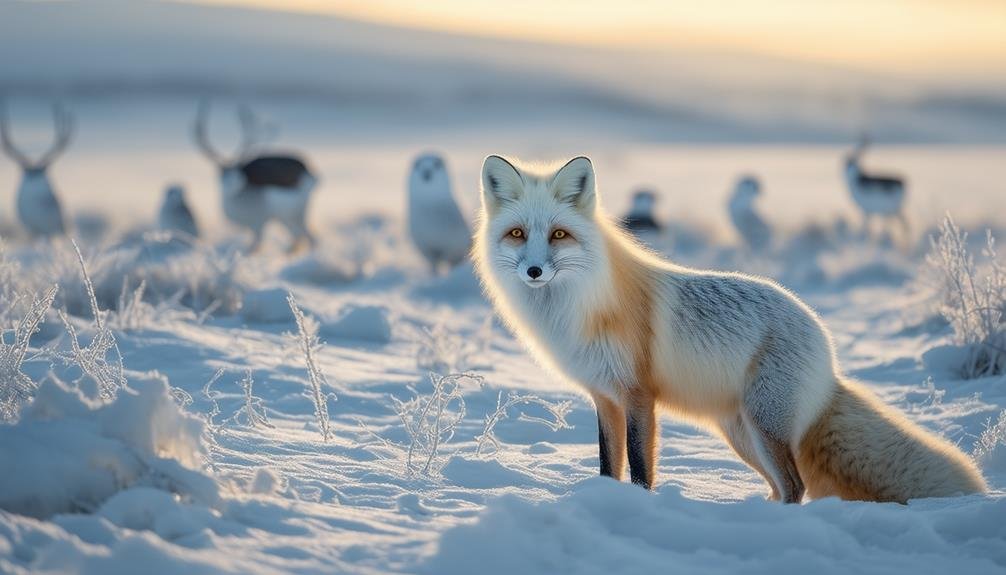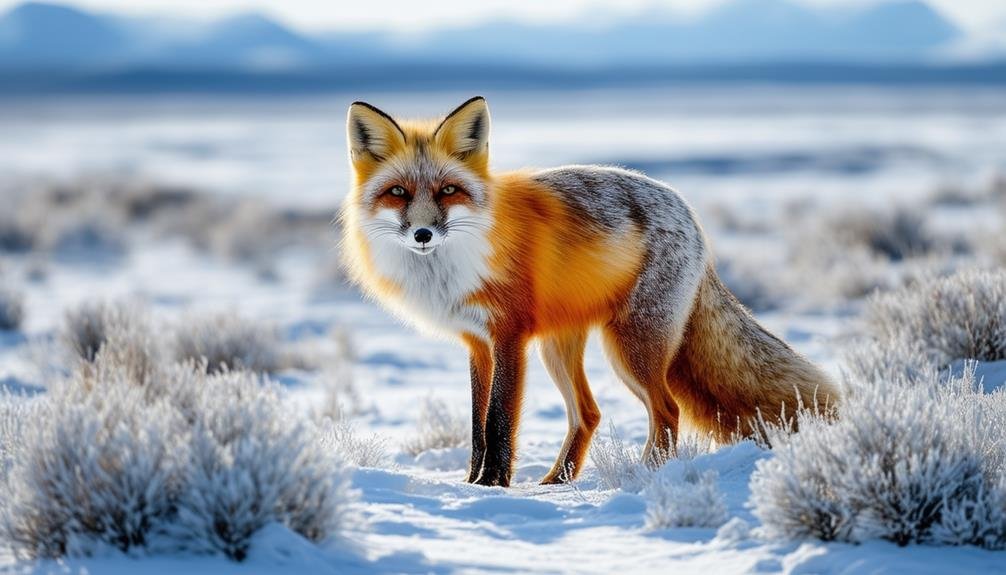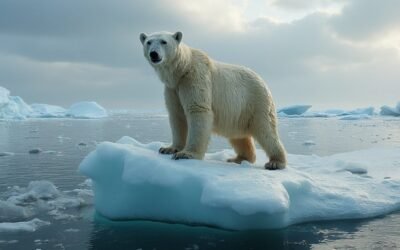The Arctic fox is essential to the Arctic ecosystem, regulating prey populations such as small mammals and birds to prevent imbalances. Their scavenging on polar bear kills aids in nutrient recycling. With a diverse diet, they maintain the delicate balance of the food chain. Adaptations like seasonal coat color changes, swift running, and underground dens support survival and reproduction in harsh Arctic conditions. Climate change and habitat disruption pose serious threats to their populations, impacting their ability to sustain vital roles. To gain further insights into these dynamics and conservation efforts, please continue to explore.
Main Points
- Arctic foxes regulate prey populations, maintaining ecological balance.
- Their scavenging on polar bear kills aids in nutrient recycling.
- They control the numbers of small mammals and birds, preventing overpopulation.
- Reproduction rates are impacted by prey abundance, influencing population dynamics.
- Arctic foxes' survival skills contribute to the overall health of the Arctic ecosystem.
Arctic Fox Adaptations
Arctic foxes display remarkable adaptations, such as seasonal coat color changes and thick tails, that enable them to thrive in the extreme conditions of the Arctic. These adaptations are vital for their survival in the harsh Arctic habitat. During winter, the foxes don a white or blue-gray coat, providing effective camouflage against the snow, which aids in hunting and evading predators. As the seasons change, their fur shifts to brown or gray, blending seamlessly with the summer tundra landscape, thereby maintaining their stealth.
Their thick tails serve multiple purposes beyond providing warmth. These tails are also instrumental in balancing, which is essential for their agile hunting techniques. Arctic foxes are swift runners, an adaptation that allows them to chase down prey efficiently in the vast, open Arctic terrain. Additionally, their ability to swim enhances their versatility, enabling them to navigate the coastal areas of their habitat.
In spring, female Arctic foxes give birth to large litters and raise their pups in underground dens. These dens offer protection from the elements and predators. Family members often assist in rearing the young, showcasing the social structure that supports their survival in the Arctic environment.
Role in Prey Regulation
In the Arctic ecosystem, Arctic foxes serve as pivotal regulators of prey populations, hunting a variety of rodents, birds, and fish. This predatory behavior is fundamental for maintaining ecological balance. By controlling the numbers of small mammals and birds, Arctic foxes prevent overpopulation, which could otherwise lead to significant disruptions in vegetation and other wildlife. Their hunting habits, including the ability to adapt to seasonal availability of prey, guarantee that no single species dominates the ecosystem, thereby sustaining biodiversity.
The Arctic fox population plays a critical role in prey regulation, effectively managing the populations of species such as lemmings and voles. During periods of high prey abundance, Arctic foxes can reproduce more successfully, leading to a natural increase in their numbers. Conversely, during prey scarcity, their population tends to decline. This dynamic relationship underscores the importance of Arctic foxes in stabilizing prey populations and preventing potential ecological imbalances.
Understanding the impact of Arctic foxes on prey populations is essential for conservation efforts. As climate change and human activities increasingly threaten the fragile Arctic ecosystem, insights into the role of Arctic foxes can inform strategies aimed at preserving the health and sustainability of this unique environment.
Interactions With Other Species

The complex web of interactions between Arctic foxes and other species underscores their integral role in the Arctic ecosystem's biodiversity. These interactions greatly influence the Arctic food chain, highlighting the Arctic fox's importance. As opportunistic feeders, Arctic foxes scavenge on the remains of polar bear kills, ensuring that no part of the carcass goes to waste and contributing to nutrient recycling within the ecosystem. This scavenging behavior also positions them as essential secondary consumers in the Arctic food chain.
Arctic foxes exhibit a diverse diet that includes rodents, birds, and fish, making them versatile predators. Their hunting activities help regulate the populations of these prey species, contributing to the stability of the Arctic ecosystem. The presence of Arctic foxes is also notable in their coexistence with other Arctic predators such as polar bears and muskox. This coexistence can lead to both competitive and symbiotic interactions, further influencing the dynamics of the Arctic wildlife community.
Moreover, the adaptability of Arctic foxes to extreme conditions underscores their role in maintaining the delicate balance of the Arctic food chain. Their interactions with other species and ability to thrive in harsh environments are pivotal in sustaining the region's biodiversity.
Reproduction and Family Life
Female arctic foxes contribute to species survival by giving birth to large litters of up to 14 pups each spring. This remarkable reproductive capacity guarantees a steady population in the harsh Arctic environment. The pups are nurtured in underground dens, providing essential protection and care during their vulnerable early weeks. Both parents play critical roles in this nurturing process, exemplifying a robust family bond that is essential for the survival of the young.
Arctic foxes exhibit monogamous breeding behavior, forming pairs that cooperate extensively during the breeding season. The male actively participates in raising the offspring, ensuring that the pups receive adequate food and protection. This cooperative behavior extends beyond immediate parental care; family groups often include multiple generations, demonstrating the species' strong family bond and collective effort in rearing the young.
This intricate family structure is vital for teaching the young essential survival skills, such as hunting and finding their way through the challenging Arctic terrain. The involvement of both parents and sometimes extended family members ensures that the pups are well-prepared to face the rigors of their environment. By fostering such close family bonds, arctic foxes enhance their chances of survival and continuity in the Arctic ecosystem.
Habitat and Range

Arctic foxes inhabit the frigid tundra and coastal regions of North America, Europe, and Asia, where they have adapted to thrive in some of the toughest environments on Earth. These resilient Arctic species are found throughout the Arctic and alpine zones, demonstrating remarkable adaptability to extreme cold and scarcity of food.
In their extensive habitat, Arctic foxes construct complex dens with multiple entrances, creating underground networks of tunnels and nests. These dens serve as essential refuges for sheltering from predators and harsh weather, as well as for raising their young. The dens' strategic design enhances the foxes' survival in an unforgiving landscape.
Arctic foxes typically maintain small home ranges close to their dens, allowing them to become intimately familiar with their immediate environment and hunting grounds. This territorial behavior is pivotal for efficiently locating prey and avoiding potential threats. Additionally, their exceptional swimming abilities enable them to traverse between ice floes and islands, expanding their range within the Arctic and alpine habitats.
Their ability to endure extreme cold temperatures is a proof of their evolutionary adaptations, making them a prominent and well-distributed Arctic species. These characteristics underscore the Arctic fox's integral role in the Arctic ecosystem.
How Does the Arctic Fox’s Role in the Ecosystem Affect Arctic Wildlife?
The arctic fox’s ecosystem role is vital for maintaining balance in the Arctic. As both predator and scavenger, it controls populations of small mammals and benefits larger predators by consuming leftovers. Its dynamic presence helps sustain biodiversity and supports the food web, directly affecting arctic wildlife’s survival and adaptation.
Conservation Challenges
The Arctic fox faces significant conservation challenges primarily due to habitat loss and the impacts of climate change. As temperatures rise, their tundra habitat is shrinking, and competition from encroaching red fox populations is intensifying. Addressing these issues requires targeted conservation efforts and increased global awareness to guarantee the survival of this iconic Arctic species.
Habitat Loss Threats
Climate change and human development are leading to significant habitat loss, posing substantial threats to Arctic fox populations. The rapid warming of the Arctic region, driven by climate change, is causing the sea ice to recede, which in turn affects the Arctic fox's ability to hunt for food and find suitable den sites. Additionally, energy development activities, particularly oil and gas exploration in the Arctic Refuge, further exacerbate these habitat challenges. As companies seek to exploit these resources, the disruption to the natural landscape and ecosystems is considerable, resulting in direct threats to the Arctic fox habitats.
Moreover, the melting permafrost, another consequence of rising global temperatures, destabilizes the dens that Arctic foxes rely on for shelter and raising their young. This destabilization not only affects the structural integrity of their homes but also disrupts their reproductive cycles, making it more difficult for populations to sustain themselves. Conservation efforts are hence essential to mitigate these impacts and protect the fragile habitats of Arctic foxes. Effective strategies must be implemented to manage human activities and address the broader implications of climate change, ensuring the long-term survival of this iconic Arctic species in an increasingly vulnerable environment.
Climate Change Impact
Rapid warming in the Arctic region is presenting unprecedented challenges for the survival of Arctic foxes. Climate change is causing the Arctic to warm at twice the global rate, severely impacting the habitat and life cycle of the Arctic fox. This rapid warming leads to significant shifts in the distribution of prey species, making it increasingly difficult for Arctic foxes to find adequate food sources.
Melting Arctic ice is another critical factor, as it reduces the available hunting grounds for Arctic foxes and heightens competition with other predators, such as the red fox. Additionally, the reduction in snow cover adversely affects the Arctic fox's natural camouflage, rendering them more susceptible to predation.
The thorough preservation of the Arctic fox must address these multifaceted challenges posed by climate change. Strategies include protecting critical habitats, managing prey populations, and mitigating the impacts of reduced snow cover. In addition, international collaboration and strong climate policies are essential to curb the overarching issue of global warming. Effective conservation efforts will require a concerted approach that considers the complex interplay of factors affecting the Arctic fox and its broader ecosystem.
Conclusion
The Arctic fox plays a vital role in the Arctic ecosystem through its unique adaptations, effective prey regulation, and interactions with other species. Its reproductive strategies and family life further illustrate its resilience in harsh environments. However, habitat range and conservation challenges pose significant threats to its population. Understanding these dynamics is necessary for developing effective conservation strategies to secure the survival of this important species and the overall health of Arctic wildlife.


